|
|
|
|
Pictures in boxes show planes flown. Combat shown with red caption. Large pictures show Hartley as pilot.
Hartley graduated from Wofford College in 1941. He had completed the ROTC program earlier in the year, but as he was not yet 21, he could not be commissioned in the Army. However, the Navy allowed him to volunteer for its Aviation Cadet program, and that summer, he was commissioned at a lieutenant/pilot in the Marine Corps. [Doyle Boggs, Wofford College website]
1941-1942 - Miami & Jacksonville, FL: Training, 2/Lt
 N3N Steerman |
 N2S |
 NR-1 Ryan |
 OS2U Cruiser scout plane |
 SNJ North American |
 F2A Brewster Buffalo |
Rich Kuykendall reports that his brother M/Sgt John H. Clackum, Navigator was at NAS Jacksonville, with Hartley.
1942 - Eva, HI: Training, 2/Lt
 F2A Brewster Buffalo |
 R5C Curtis Commando |
1942 - Guadalcanal: Combat, 2/Lt; VMF-223, VMF-224, with 1st Division (8/30/1942 - 10/16/1942)
9/13/42 - Air Medal: "For meritorious achievement while participating in aerial combat with Marine Aircraft Group Twenty-Three against enemy Japanese forces in the Solomon Islands Area on September 13, 1942. When his section leader, during a furious engagement with Zero fighters, made a run on one of the hostile planes and missed, Second Lieutenant Hartley, observing that the enemy had turned and was viciously strafing his companion, launched a vengeful attack against the Japanese Zero and shot it out of the sky. By his superb air discipline, maintained at great personal risk in the face of grave danger, he not only destroyed an enemy plane but also saved the life of his section leader."
8/31/42-9/5/42 - Gold Star in lieu of a second Air Medal: "For meritorious achievement in aerial flight as Pilot of a Fighter Plane in Marine Fighter Squadron Two Hundred Twenty-Four during operations against enemy Japanese forces in the Solomon Islands Area, from 31 August to 5 September 1942. Completing his fifth mission during this period, Second Lieutenant Hartley carried out combat patrols and strafed hostile ground troops in the face of aerial opposition, thereby contributing materially to the success of his squadron. His skilled airmanship and courageous devotion to duty throughout these hazardous missions were in keeping with the highest traditions of the United States Naval Service."
9/5/42-9/10/42 - Gold Star in lieu of a third Air Medal: "For meritorious achievement in aerial flight as Pilot of a Fighter Plane in Marine Fighter Squadron Two Hundred Twenty-Four during operations against enemy Japanese forces in the Solomon Islands Area, from 5 to 10 September 1942. Completing his tenth mission during this period, Second Lieutenant Hartley carried out combat patrols and escorted bombers on strikes against hostile installations, thereby contributing materially to the success of his squadron. His skilled airmanship and courageous devotion to duty throughout these hazardous missions were in keeping with the highest traditions of the United States Naval Service."
9/14/42-9/20/42 - Gold Star in lieu of a fourth Air Medal: "For meritorious achievement in aerial flight as Pilot of a Fighter Plane in Marine Fighter Squadron Two Hundred Twenty-Four during operations against enemy Japanese forces in the Solomon Islands Area, from 14 to 20 September 1942. Completing his fifteenth mission during this period, Second Lieutenant Hartley participated in combat patrols and escorted bombers on a strike against hostile troops, thereby contributing materially to the success of his squadron. His skilled airmanship and courageous devotion to duty throughout these hazardous missions were in keeping with the highest traditions of the United States Naval Service."
9/24/42-10/6/42 - Distinguished Flying Cross: "For heroism and extraordinary achievement in aerial flight as Pilot of a Fighter Plane in Marine Fighter Squadron Two Hundred Twenty-Four during operations against enemy Japanese forces in the Solomon Islands Area, from 24 September to 6 October 1942. Completing his twentieth mission during this period, Second Lieutenant Hartley carried out combat patrols and escorted bombers in attacks on hostile installations, thereby contributing materially to the success of his squadron. His skilled airmanship and courageous devotion to duty throughout these hazardous missions were in keeping with the highest traditions of the United States Naval Service."
"See Time of Aces: Marine Pilots in the Solomons, 1942-1944" [external link] for a description of this part of WWII.
Hartley in F4F Wildcat |
 Hartley in F4F Wildcat |
Shortly after the Marines landed at Guadalcanal on Aug. 7, 1942, they established a defensive perimeter around the half-finished, 2,400 foot-long airfield that had been their objective. Within three weeks, some 60 U.S. aircraft were in place and an extended battle for air supremacy in the area ensued. The Japanese were equipped with heavy bombers and their famous Zero fighter. Most of the Americans (including Lt. Hartley) flew the Grumman F4F “Wildcat,” designed for aircraft carrier operations. It was a sturdy fighter with adequate firepower, but it was no match for a Zero in a dogfight. Under those conditions, keeping the airfield and the American planes in operation required amazing ingenuity and courage.
Hartley fought on Guadalcanal for three months, heading back to Spartanburg on Nov. 18, 1942, for his wedding to Ruth Boyd. Before they began a two-week honeymoon leave, he agreed to an interview by the Old Gold and Black student newspaper, which published a fascinating account of Hartley’s first combat tour. The article had a particularly vivid description of the “Thach Weave,” a complicated maneuver involving a team of two Wildcats that offset the technical advantages of the Zeros. Hartley matter-of-factly described his four individual kills (two Zeros and two bombers), plus another victory that he shared (scored as 4 1/2 kills). [Doyle Boggs, Wofford College website]
Izzy and the Iquana:
Izzy's name wasn't Izzy; he was just called Izzy. One night the squadron had been warned of Japanese attempts to infiltrate the airbase. Everyone was on edge. In the middle of the night a scream rang out. Hartley rolled off his cot and grabbed his 45. He and the squadron commander crawled in the direction of the scream to Izzy's tent. They called out, "Are you all right?" Izzy yelled, "I've got him!" Upon lighting a lantern, they discovered Izzy flat on his back on his cot with his mosquito net collapsed over him, hands in a death grip around the neck of a large -- iguana!Bombing Run:
Hartley recalled one night when he was in his tent and heard something go “wheeeee.” “I said, it’s time for me to get outside and into my hole, so I crawled in,” he said. “It was about 10 yards from my tent and reinforced with sandbags… Bombs fell for three hours while I was lying flat on my stomach with my mouth full of dirt. About four o’clock in the morning I stepped out of my little hole and fell into a big one. A 500-pound bomb had landed squarely on my tent!” [Doyle Boggs, Wofford College website]Pictures of Hartley on Guadalcanal
September 1942, a night picture on Guadalcanal - not an unusual way to spend an evening.
Note table in the center - and the main attraction - evening refreshments.
L-R: H. Walter, Irwin, Johnson, Matt Kennedy, Dr Roe, Armistead, Dobbin (bare legged)
D'Arcy (standing), Charley Kunz, John C. Musselman, Pop Fuller (standing), Tex (with cup),
Geo. Hollowell (next to Tex), Hartley (standing), Nicolay (face hidden), Galer (leaning back),
Quilter, Fike
Broken F4F
Pilots and officers of VMF 224, the Air Group, and the 1st MAW on Guadalcanal
Same time as picture above - officers whose faces are visible are identified from left to right:
Howard Walter, "Slim" Irwin, A. M. Johnson, Dr. Roe, Maj. John Dobbin - Sqdn Exec (later BGen. winner of the Navy Cross),
Maj. Kirk Armistead, Bob D'Arcy (standing), Charley Kunz, Maj. Bob Galer - Sqdn CO (standing center, winner of the Medal of Honor),
CWO "Pop" Fuller, Eng. Off (standing rear), John Musselman (seated in front of "Pop"), Dean Hartley, Ken Frazer, George Hollowell,
Matt Kennedy, Maj. "Chick" Quilter (later MajGen), LtCol Charley Fike - Group ExO
Picture below from The Cactus Air Force website [external link].
|
| THE OLD GOLD AND BLACK, Wofford College, December 5,
1942 HARTLEY BAGS TWO ZEROS AND TWO BOMBERS, GUADALCANAL A guy who saw action in the air above Guadalcanal, was bombed, shot at by Jap Zeroes, who shot down two Zeroes himself and was in on the kill of two bombers, is getting married this afternoon in Spartanburg - and we don't know which thought scares him more. That's Dean Hartley, 1941 Wofford Graduate, all wrapped up for you in one sentence. We interviewed Dean in a room in Carlisle Hall, where, sprawled in a straight-backed chair, he told us something of his activities since leaving this campus. David "Goof" Prince, as occupant of the room, was kibitzer and supplied some of the questions. When Dean graduated from here he was commissioned a second lieutenant in the Army Infantry. Soon afterwards he was transferred to the Naval Air Corps, taking his first training at the Miami Naval Reserve Air Base. He moved to Jacksonville for several months of training, then back to Miami for his final instructions. After being commissioned there, he was transferred to the Marine Flying Corps. He has been in that branch ever since. Hartley flew as wingman to the Major, in this outfit. Flyers work in pairs for sky fighting, two of them attacking simultaneously. His first score in the air was a bomber, which he shared with the Major. The action occurred the second time he was in the air at Guadalcanal. A formation of bombers were reported by observation posts, and when Hartley and his group arrived, they found the bombers supported by a formation of Zeroes behind them and above. "The Major and I made an overhead run (swooping down from above) on the left hand bomber, firing as we went by. Reports from observation posts showed that he didn't get home and our planes behind us said he was smoking after we went by, so we figure we got him." As to nervousness, Dean said he didn't have time for that. "The first time I was up I was nervous. The second time things happened so fast I didn't have time to be nervous." "As a matter of fact," he broke into his story, "the most fun didn't come when I shot down a Jap but when I nearly got shot. One time the Skipper and a few others and I were flying around, when three of us got separated from the others because of the clouds. All at once we saw eight Zeroes. Two of us turned for home, but the other guy decided he wanted to get him a Zero, so he went after him. When I looked back, there he was with a Zero on his tail. I turned around and scared the Zero off him, but when it was over I had bullet holes in the wings of my plane where the Jap had come close to me." Dogfights, the favorite of the past World War where planes milled around in a large circle as they fought, are a thing of the past, Hartley declared. Now you just zoom down from above and hit 'em and keep going. If you miss with your first burst, you don't go back for more. Dean shot down his first Jap plane less than three months ago, on September 13. "The Major and I and a couple more were coming down after some Zeroes a few miles away. We were flying about 1,000 feet up when I saw a Jap on the tail of my buddy who was flying my plane that day. I turned down on him, got behind him and fired three short bursts (from six guns) at him. He was right in my sights. I couldn't miss. As I went by I saw flames in his cockpit. At 5,000 feet I looked back and saw him spin down in flames." The food at Guadalcanal, Dean says, is sufficient. "For awhile there I ate Jap rice, Jap spaghetti, and Jap hardtack fro captured stores." "I got my second Zero when I was up with the Skipper and four others. There were heavy cloud layers that day and as we came through one layer we looked up and saw twelve Zeroes above us. Two of our boys went home, but before we got through the clouds we were among the Zeroes. "Well, we milled around and the Skipper got one. After that I didn't wait to see any more. I turned over and went straight down - burned out an engine doing it. I landed with smoke in my cockpit while an air raid was going on. I hopped out and ran like hell for a fox hole, where I stayed until the raid was over." Hartley said that he had seen one instance in which a Jap fighter attempted to machine-gun a flyer as he parachuted to earth. The Jap missed and was shot down by the Colonel of the outfit, an old head at fighting "who had just gotten four Zeroes that morning." Goof Prince chimed in with a don't-the-dead-ones-haunt-you question. "The dead ones don't, but the live ones do. They come over at night and drop shells and blow up my tent and my uniform and try to blow up me. One time I lost $400 worth of uniforms." "I remember one night," Dean said, "I was in my tent when I heard something go wheeeeeee. I said, it's time for me to get in my little hole, so I crawled in. It was about ten yards from my tent and reinforced with sandbags - but more for morale than anything else. Bombs fell for three hours while I was lying flat on my stomach with my mouth full of dirt. About four o'clock in the morning they stopped. I stepped out of my little hole and fell into a big one. One 500-pounder had landed squarely on my tent." Hartley stated that his squadron had taken some Jap prisoners, but that he knew little about them. "Some of them look intelligent, some don't. I just looked at them while they were walking around in the bullpen." Dean's last plane was shot down on his last hop before returning to the United States when he went up with his squadron after "about twelve bombers." The Major got one and he got one. After this encounter he returned to the States, reaching San Diego, California, on November 18. In about two more weeks Dean's leave will be up and he will return to active duty - but he doesn't know where. |
|
|
|
|
|
|
1943 - Mojave & Tehachapi, CA: Training, 1/Lt, Capt
 SBD dive bomber |
 FM2 Wildcat |
 F4U Corsair |
 SNB |
During training on the F4U Corsair, it was emphasized that the plane was so stable that it could not be landed upside-down. Hartley proceeded to demonstrate that falsity of this proposition. A sudden gust of wind at the last moment of landing flipped the plane. Hartley found himself hanging from the seat belt after releasing the canopy. When he released the belt, he landed on his head, getting a cut. He was standing out of the plane looking at it when the fire engine and emergency crew arrived. They yelled at him, "Don't just stand there! Help us get the pilot out!" Hartley said, "... I am the pilot."
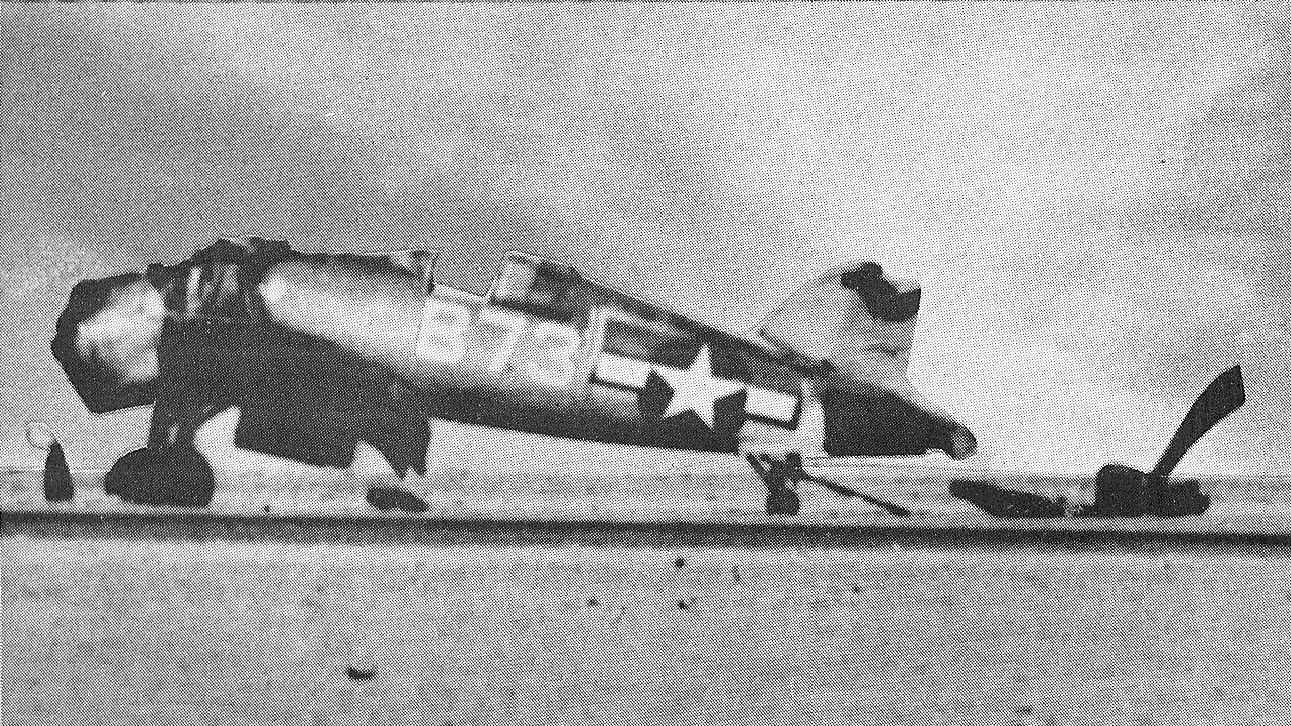 Hartley showed that you CAN land a Corsair upside-down |
4 Aug 1944 - Espiritu Santos, Marianas, Guam: Combat, Capt; VMF-225, arrived 4 Aug 1944 [external link]
8/7/44-8/18/44 - Gold Star in lieu of a fifth Air Medal: "For meritorious achievement in aerial flight as Pilot of a Fighter Plane in Marine Fighter Squadron Two Hundred Twenty-Five during operations against enemy Japanese forces in the Marianas Islands Area, from 7 to 18 August 1944. Completing his twenty-fifth mission during this period, Captain Hartley carried out hazardous combat air patrols and furnished cover for a torpedo bombing strike on Rota Airfield, pressing home a vigorous strafing attack which contributed materially to the success of his squadron in the infliction of damage on the enemy. His skill as a leader and airman and courageous devotion to duty in the face of grave hazards were in keeping with the highest traditions of the United States Naval Service."
8/25/44-9/14/44 - Gold Star in lieu of a sixth Air Medal: "For meritorious achievement in aerial flight as Pilot of a Fighter Plane in Marine Fighter Squadron Two Hundred Twenty-Five during operations against enemy Japanese forces in the Marianas Islands Area, from 25 August to 14 September 1944. Completing his thirtieth mission during this period, Captain Hartley carried out hazardous observation flights and launched daring bombing and strafing attacks against hostile installations on Rota, thereby contributing materially to the infliction of damage on the enemy. His skilled airmanship and courageous devotion to duty in the face of grave hazards were in keeping with the highest traditions of the United States Naval Service."
9/22/44-10/19/44 - Gold Star in lieu of a seventh Air Medal: "For meritorious achievement in aerial flight as Pilot of a Fighter Plane in Marine Fighter Squadron Two Hundred Twenty-Five during operations against enemy Japanese forces in the Marianas Islands Area, from 22 September to 19 October 1944. Completing his thirty-fifth mission during this period, Captain Hartley carried out hazardous observation flights and launched vigorous bombing and strafing attacks against hostile installations on Rota, thereby contributing materially to the infliction of damage on the enemy. A skilled airman, Captain Hartley by his courage and devotion to duty in the face of grave hazards upheld the highest traditions of the United States Naval Service."
10/24/44-11/30/44 - Gold Star in lieu of a second Distinguished Flying Cross: "For heroism and extraordinary achievement in aerial flight as Pilot of a Fighter Plane in Marine Fighter Squadron Two Hundred Twenty-Five during operations against enemy Japanese forces in the Marianas Islands Area, from 24 October to 30 November 1944. Completing his fortieth mission during this period, Second Lieutenant Hartley carried out hazardous observation flights and launched vigorous bombing and strafing attacks against hostile installations on Rota and Pagan, thereby contributing materially to the infliction of damage on the enemy. By his skilled airmanship and courageous devotion to duty in the face of grave hazards, Captain Hartley upheld the highest traditions of the United States Naval Service."
12/3/44-12/11/44 - Gold Star in lieu of a eighth Air Medal: "For meritorious achievement in aerial flight as Pilot of a Fighter Plane in Marine Fighter Squadron Two Hundred Twenty-Four during operations against enemy Japanese forces in the Marianas Islands Area, from 3 to 11 December 1944. Completing his forty-fifth mission during this period, Captain Hartley carried out hazardous observation flights and pressed home bombing and strafing attacks against hostile installations on Rota and Pagan, thereby contributing materially to the success of his squadron in the infliction of damage on the enemy. His skilled airmanship and courageous devotion to duty in the face of grave hazards were in keeping with the highest traditions of the United States Naval Service."
 Hartley in F4U Corsair -Brat II? (upper plane is a reflection) |
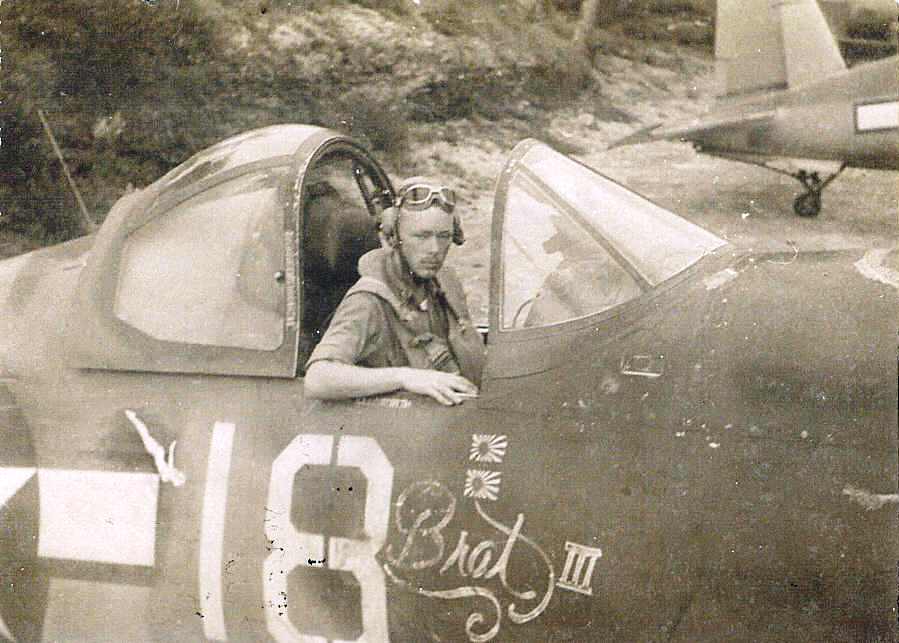 Hartley in F4U Corsair -Brat III |
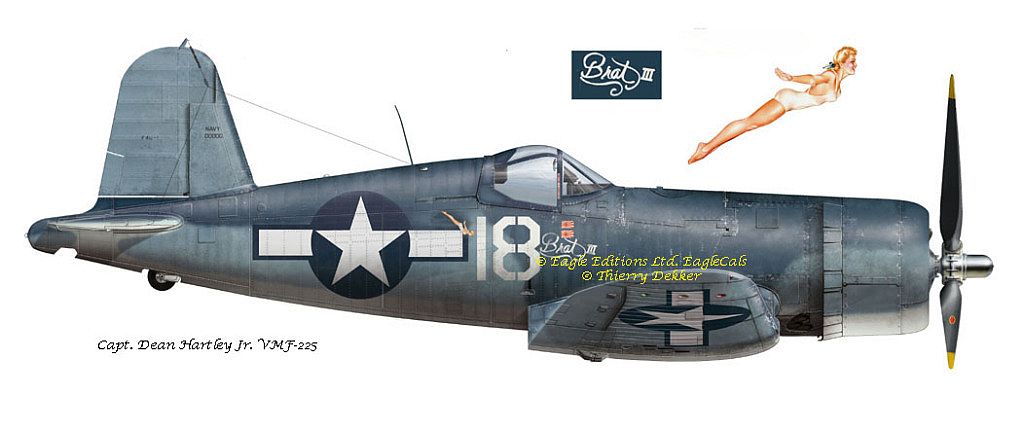 Painting of F4U Corsair -Brat III (artwork on plane by Dean Hartley) |
|
VMF 225 Turtle Bay Espirtu Santos, French New Hebrides Islands, May 11?, 1944, in front of F4U-1 Back row L to R: Dan V. Hayes, Paul Caruso, Olin G. Wollen, Vernon B. Dodge, John M. Vanderscoff, Hunter H. Craig, James D. McGough, Jack Butler, John A. Browne Jr, James O. Seay, Roland V. Vaughn, Joe Crandall, Spencer B. Weills, Joseph H. Boyland, William T. Stratton, Herbert R. Waltz, Ted Musick, Kenneth L. Mann Center row L to R: William K. Vance, Robert Washbon, Bob Karcher, Dick Driggs, Kieran S. McManus, John D Mitchell Jr, Carl Coon, Bruce H. Wallace, John L. Shearer, James V. Wilkins, Charles Carr, Vernon H. Salisbury, Jack N. Nearhood, Joseph Morin, Robert F. Harvey Front row L to R: Barney Youngblood, Gus Saridakis, Ed Hartford, Ed Galligher, Robert R. Read, Jack R. Amende, James A. Embry, George S. Buck, Doc G. E. Legg Dean S. Hartley Jr, H. Dennis Griffith, William J. Gill, Jack VanHousen, Tony Comstock |
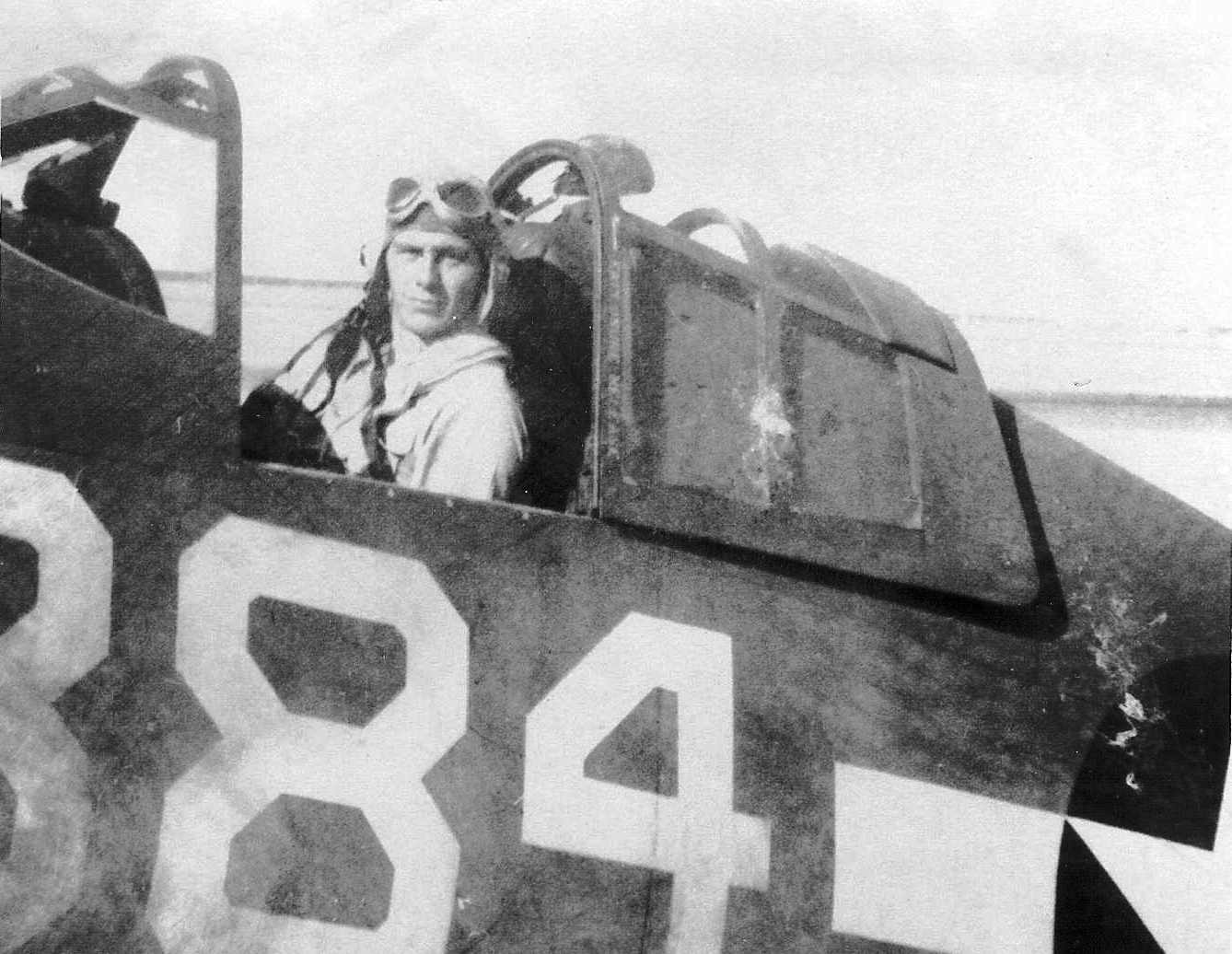 Jack van Heusen |
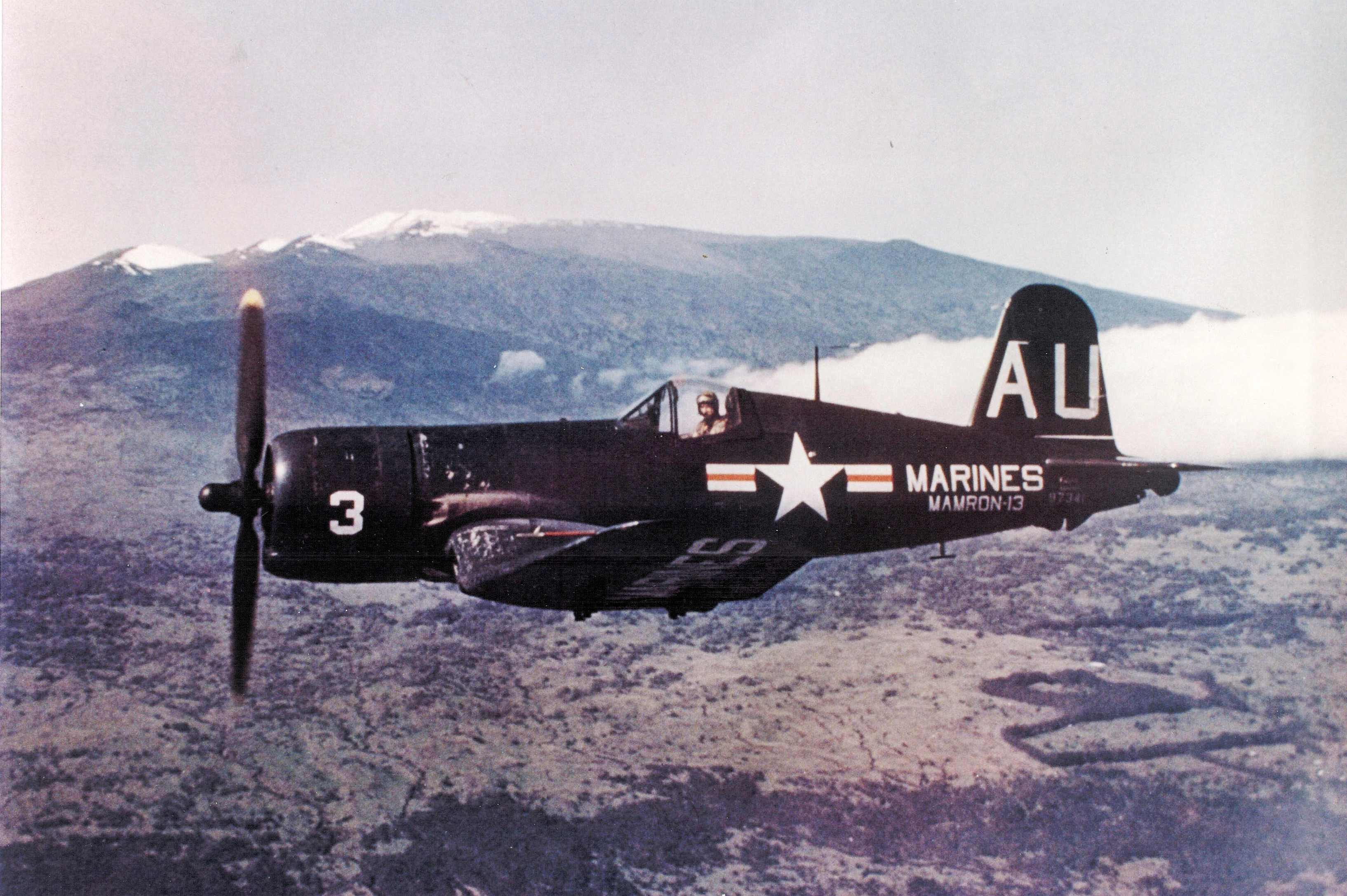 John Mitchell flying Corsair past Mauna Kea, taken by Phil Harris 7 May 1953 |
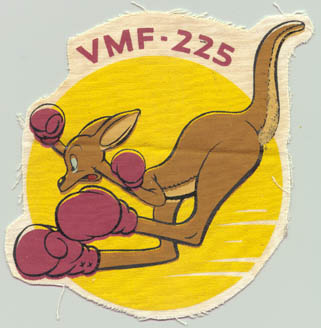 |
|
On the left is the first design of the insignia of Marine Fighter Squadron 225. It was designed by Walt Disney Studios while the squadron was still in training at the Mojave Desert in 1943. The squadron personnel felt that the emblem was too cutesy and they decided against using it, accepting instead the insignia of Death in a Top Hat dealing a USMC card. VMF 225 was commissioned on 1/11/43 and saw action in the South Pacific on EWA, Espiritu Santos, Enivetok, and Guam. |
|
1945-1946? - Columbia, SC: Training?, Major
 F4U Corsair |
1946?-1948 - Honolulu, HI: Asst. G-1 Air Fleet Marine Forces Pacific (AirFMFPac), Major, reverted to permanent rank of Capt, re-promoted to Major
 DC3 |
 Beechcraft |
Tsin Tao & Peking, China (TDY from Honolulu)
1948-1950 - Camp Pendleton, CA: Asst. G-1 1st Marine Division
 OY1 |
 R4D |
1950-1951 - Mountain View, CA: Student, Masters degree at Stanford
 F6F Hellcat |
1951-1952 - Cherry Point, NC:
 F4U Corsair |
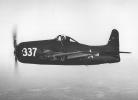 F8F Bearcat |
 F7F Tigercat |
 TV1 |
 SNB |
Patuxent (TDY from Cherry Point): Test pilot
 PB4Y single tail Liberator |
 PB5A flying boat with landing gear |
 F2G Super Corsair (only built 5) |
Sandia, NM (TDY from Cherry Point): Student, Nuclear Weapons School
1952-1953 - Miami, FL: Air Field Operations Officer, Lt Col promotion
 F9FP Panther - photo version |
 R5C Curtis Commando |
 R4D Douglas DC3 |
 Beechcraft |
 TBM "Turkey" torpedo bomber |
1953-1954 - Korea (family in Spartanburg, SC): Combat, LtCol; Commanding Officer MAMS-33 Marine Air Maintenance Squadron, located at K-3 airbase, near Pohang, Korea.
 |
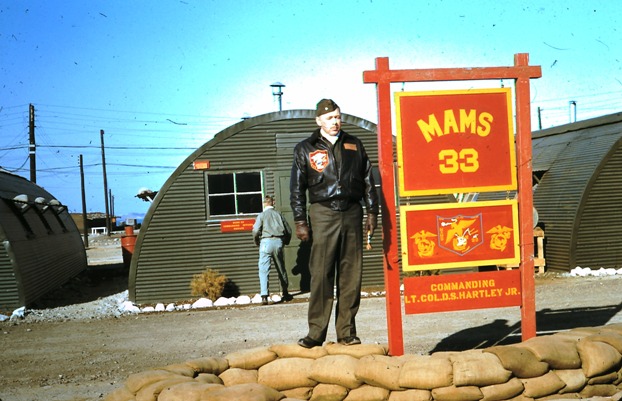 |
Rich Kuykendall reports that he was a First Lieutenant at K-3. He was an Air Control Officer with MACS-3 on the point. He controlled a pilot from K-3 in a TBM, who found Kuykendall's radar plot off the coast to be a destroyer. It was reflecting off the clouds at 4000 feet. Kuykendall thought it might be "Bedcheck Charlie." The pilot came back to him: "Splash one destroyer!"
|
|
|
|
Commanding Officer VMFA-115 [external link] Marine Fighter Attack Squadron-115 (see movie
).
|
|
|
(LtCol "Lightfoot" Hartley [very graceful dancer] then "Major Clubfoot" Hartley [stuck foot through floor of Japanese dance hall])
Hartley in F9F Panther |
See Hartley flying F9F in short
(25 second) movie . If that
works on your computer, you may want to watch an
extended version
. If that
works on your computer, you may want to watch an
extended version (9 minutes) with
music.
(9 minutes) with
music.
|
|
|
|
|
|
 F9F |
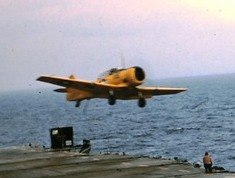 SNJ |
 HRS-1 helicopter |
1954-1955 - Quantico, VA (lived in Alexandria, VA): Student, 1st MAIS, research paper, "What Degree of Pilot Proficiency is Required for the Marine Aviator Assigned to Billets Outside the Marine Aircraft Group or Squadron?" [external link].
 F4F |
1955-1957 - Niagara Falls, NY: LtCol; Commanding Officer, Marine Air Reserve Training Detachment (MARTD)
 F2H Banshee |
1957-1960 - HQMC (lived in Alexandria, VA): Head, Enlisted Detail Branch
 AD1 Douglas |
 Beechcraft |
 T28 Fighter trainer |
1960-1961 - Newport, RI: Student; Naval War College
 SNB |
1961-1963 - El Toro, CA: Col; Commanding Officer, VMGR-352 Marine Aerial Refueler Transport Squadron Commanding Officer-352 (VMGR-352)
 F9F-8 Cougar |
 GV1 (KC-130) refueler |
1963-1964 - Iwakuni & Vietnam (family in Orange, CA): Combat; Asst. C/S Wing Comptroller
Hartley in GV1 (KC130) refueler |
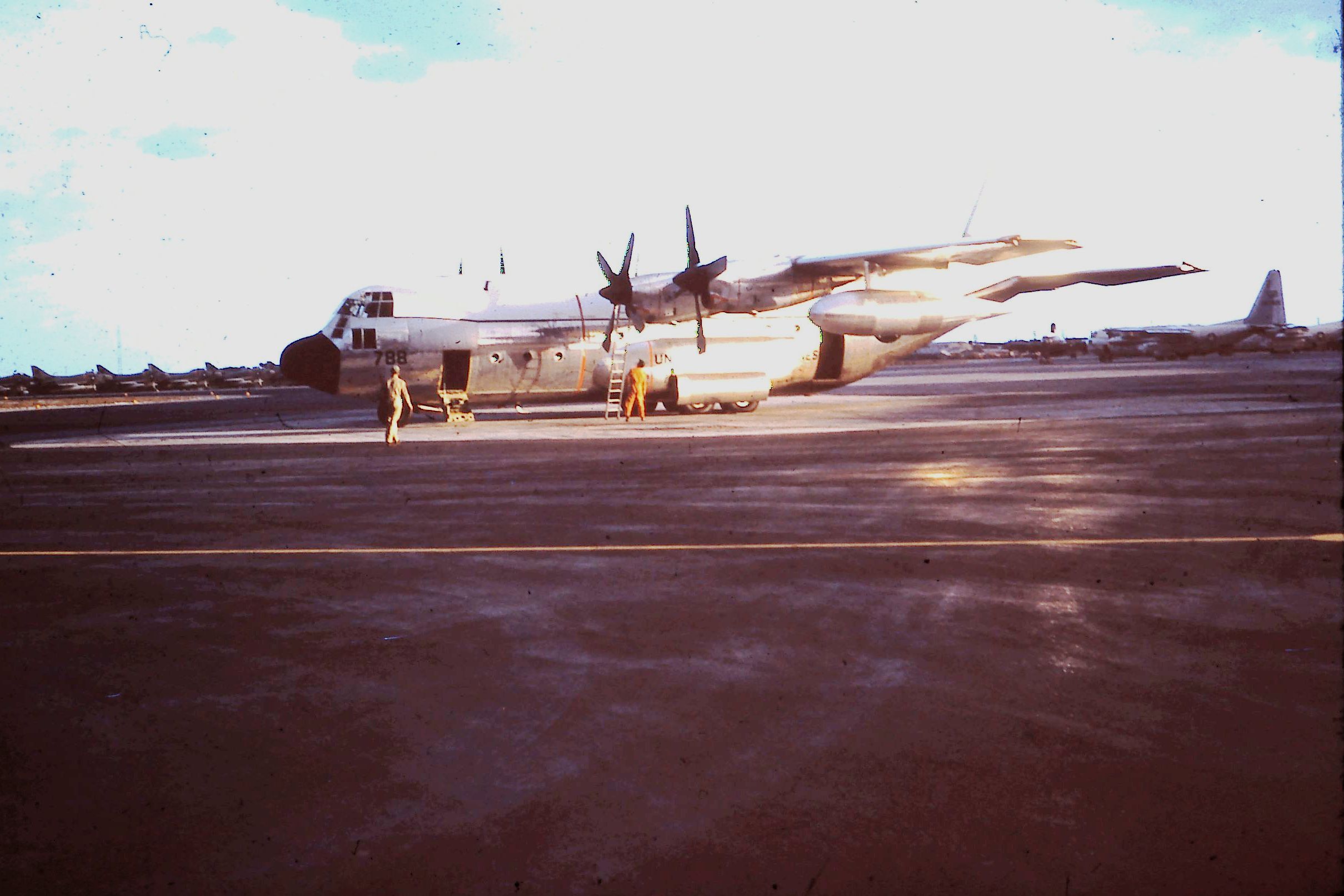 GV-1 at El Toro |
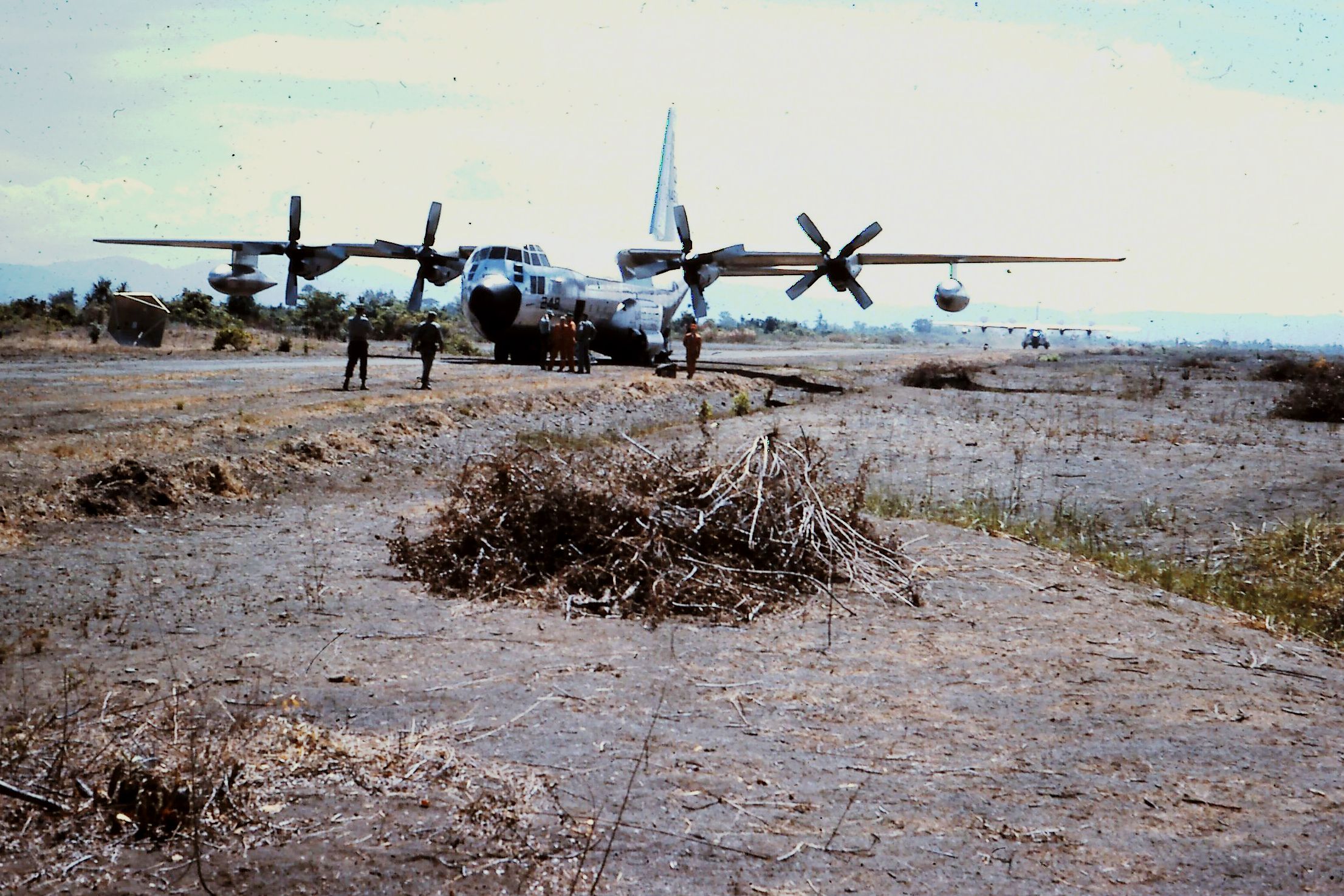 Hartley and GV-1s somewhere in Southeast Asia |
|
|
 |
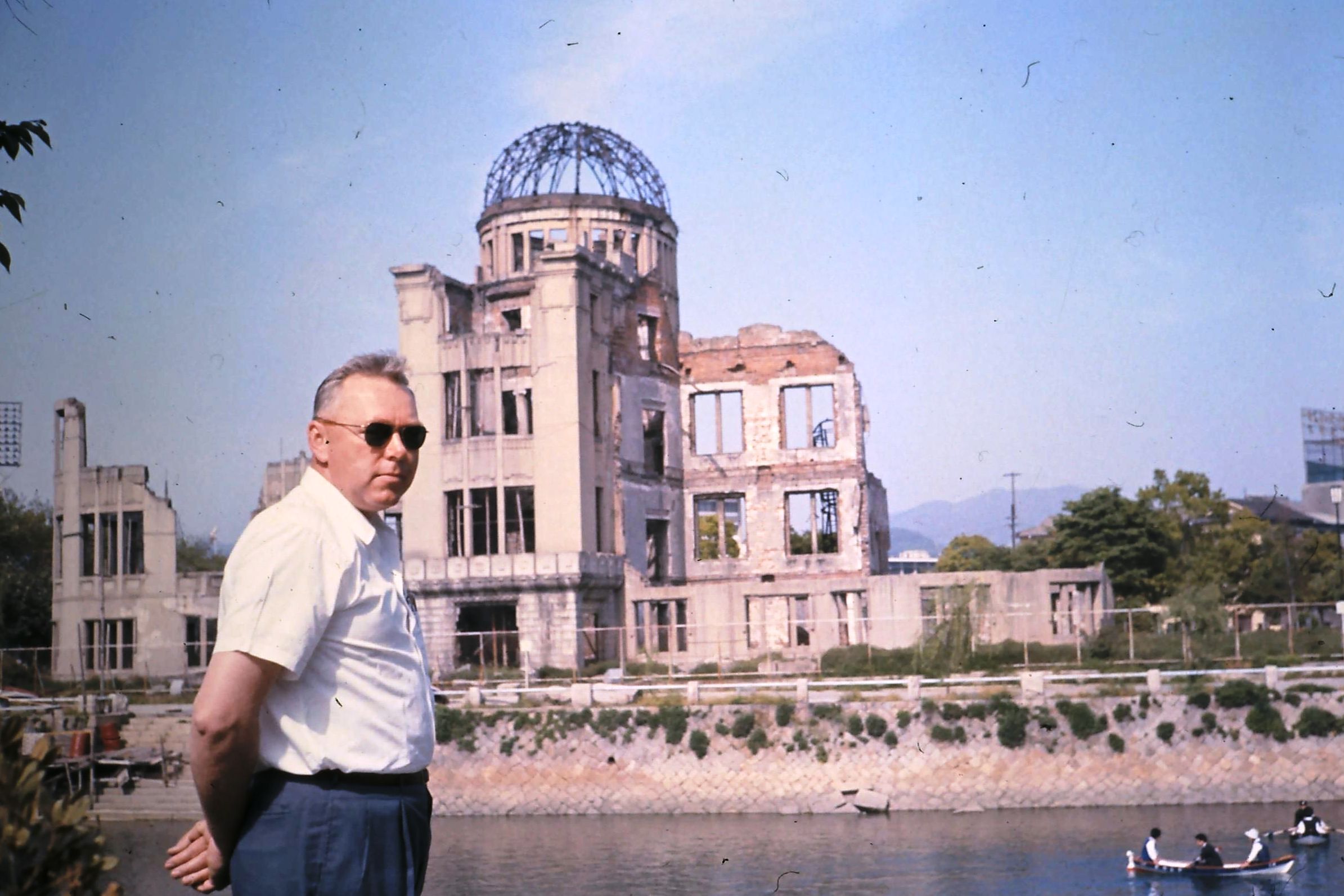 Hiroshima |
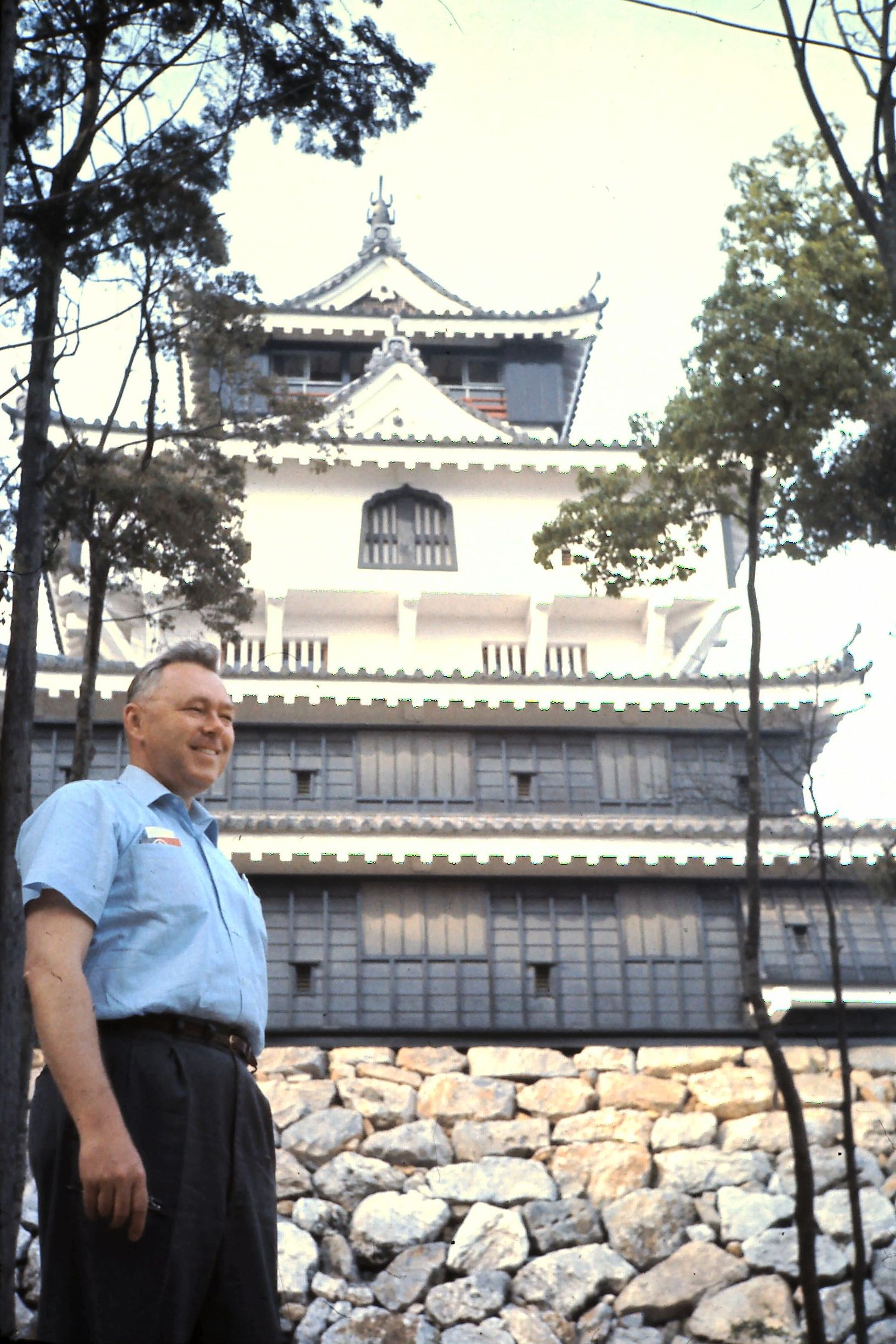 |
|
|
|
1964-1969 - Newport, RI: Col, Deputy Head and Head of School of Naval Warfare, Naval War College
 SNB |
1969-1971 - Quantico, VA: Col, Director, Marine Corps Extension School, retired Jan 31, 1971
 SNB |
 T28 |
1971-2010 - Monroe, LA: Retired from Marines, Founder of NLU Aviation Department, retired from that
Resurrection of a FossilBy A "fossil" is defined by Webster as "antiquated; dead to change or progress." Unfortunately that description may, too often, be applied to teachers and professors, Marines who fought in World War II, public personages who have been too long at the seat of power, or even chronologically young people who have ceased to learn or to recognize the joys of new experiences. Here we have, in Colonel Hartley, one who might fit into several of those categories - a World War II Marine pilot, a professor of Aviation at NLU, and to some extent a bureaucrat of thirty-five years' experience. But this is not a serious philosophical story with deep overtones of grave import. Instead, let's call it a "Rescue Mission." Simply stated, Dean Hartley was for thirty years a Marine Pilot, and flew most of the planes from fabric biplanes of the 1930's to swept wing jets and KC-130 Hercules aerial refueler/cargo planes. Somehow, though, in his last six or seven years in the Marine Corps he did very little actual flying - and on coming to NLU to head the Aviation program he decided that the little Cessna 150 type of plane presented no apparent challenge, so there wasn't a great deal of flying there either. After all, there was all that (bureaucratic) paper work to attend to. But then Bob Speed showed up with a bright yellow SNJ-6 (AT-6 to you Air force types), a plane Dean had first flown thirty-four years before, and last flown twenty-two years before. Then there was Jimmy Fordham, a graduate of the NLU Aviation program in August of 1975, and now a corporate pilot with Ford, Bacon, and Davis. Jimmy was also "the other" pilot besides Bob Speed (a corporate pilot with Olinkraft) whowas checked out in the SNJ. So when Dean saw the SNJ, there wsa a re-kindling of an old love - and Jimmy was elected to instruct his old instructor. In 1.6 hours, Dean was sent off to solo (again). Then Jimmy and Dean went out and did some real flying - a few loops here, a slow-roll there, a chandelle over younder, an Immelman up above, and finally a hammer-head or two. |
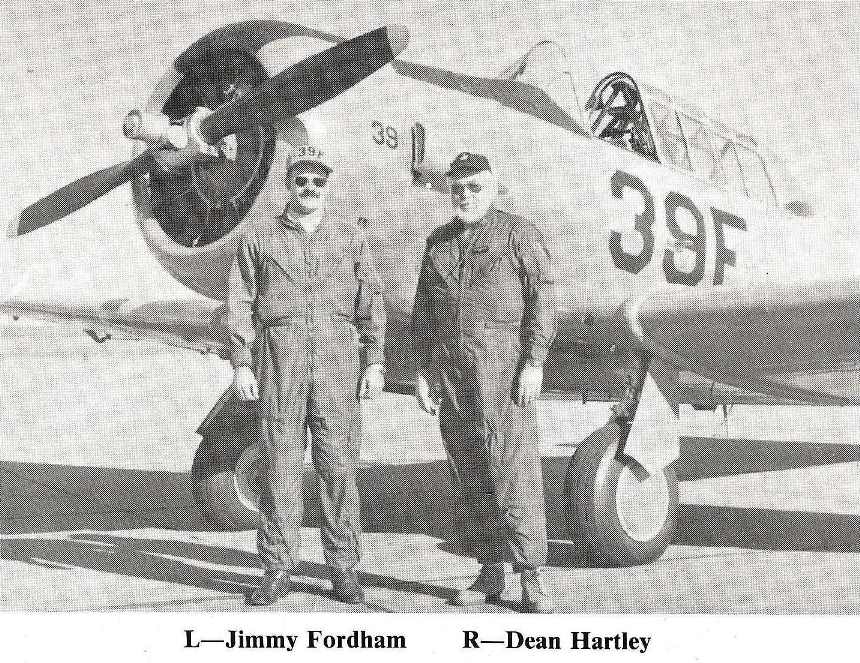 |
And the net result is that the incipient fossil (see definition at the beginning of this story) Dean is once again a genuine, flying pilot. He flies for the pleasure and joy of it, he takes his students and friends for rides - he even got his wife up with him in a plane for the first time in thirty-two years - and is now working on renewing his instrument rating by taking the FAA Instrument Course. It would be safe to say that the serendipitous concatenation of events - the bright yellow SNJ, the Jimmy Fordham student turned teacher, and Dean Hartley the teacher turned student, resulted in the re-birth (rescue) of a (potential) fossil. It would also follow that everyone should benefit, and particularly Dean's students who might be induced to listen a little more attentively to his words of advice. After all, they know now he really is a pilot who just might be up there in the air at the same time they are - after thirty-five years, at that. If you should look for a message or moral, perhaps you could use the old saying: "You're only as old as you feel." Or perhaps you could suggest that if you think you're "over the hill," then you certainly are. You could also say, though, that one of the real joys of living is to keep on learning, or re-learning - keep on looking for the other side of the hill, the back of the next cloud, the thrill of doing something well. Fine! That's one way to keep the dreadful gray of senility and oblivion away - and to maintain the frame of mind which makes true accomplishment a joy, day to day. For all children, of all ages. Late flash! Jimmy and Dean have just bought the original Midget Mustang (Long LA-1, side number N6V), a very small, very sleek, very agile single seater. Vive la children. See page 21. From Louisiana Flight Patterns, Vol. 6 No. 1, Spring 1978. |
 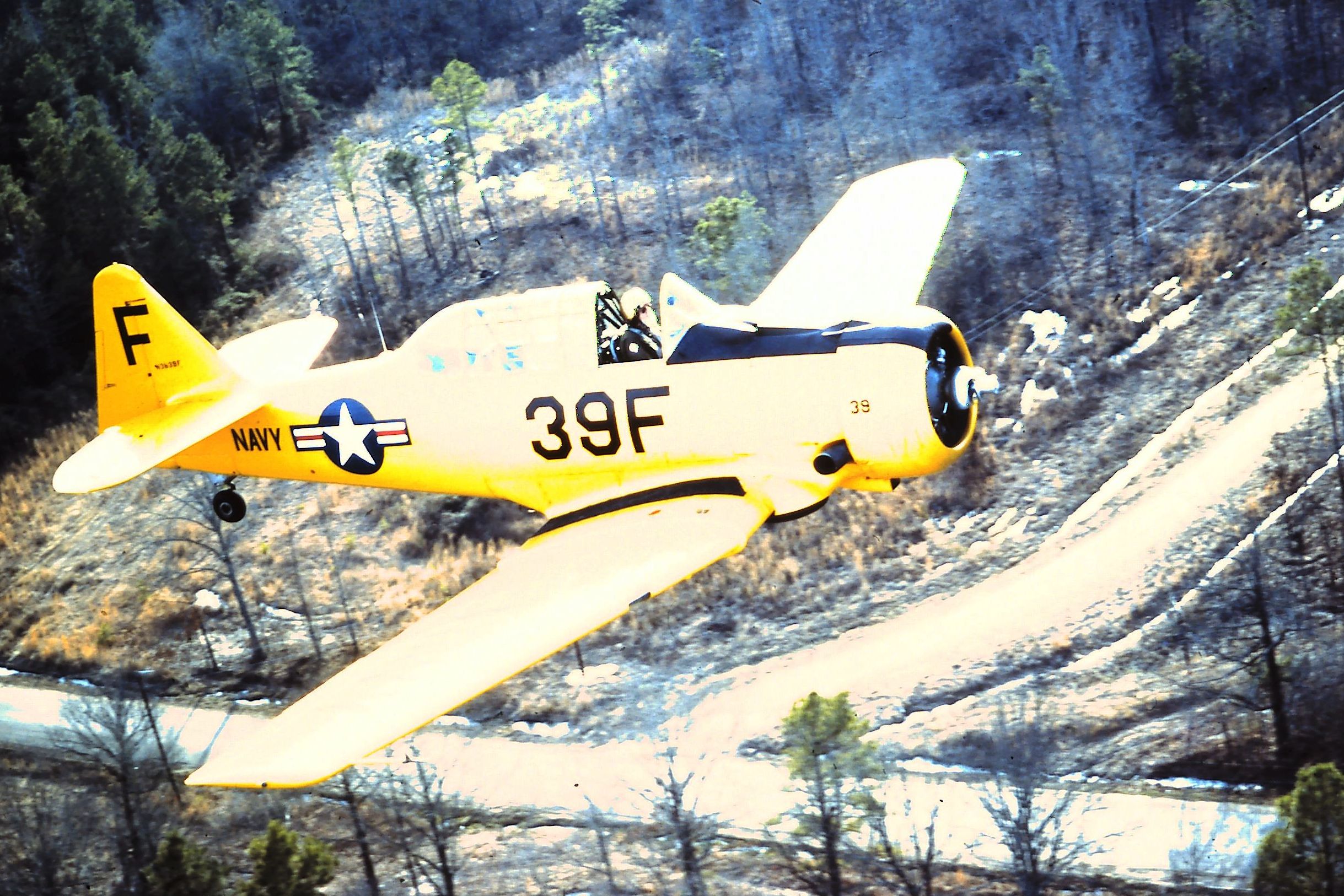 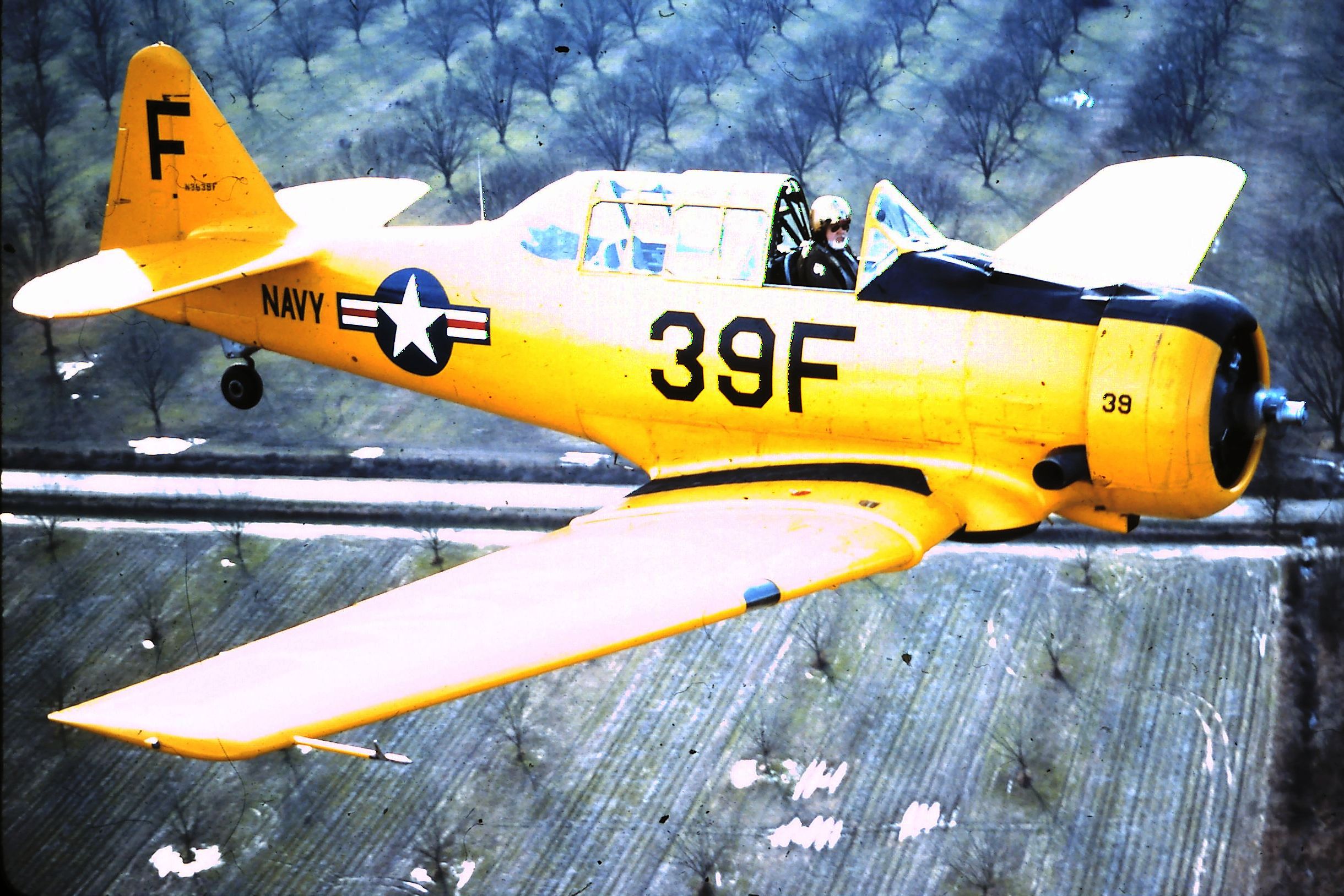  |
 |
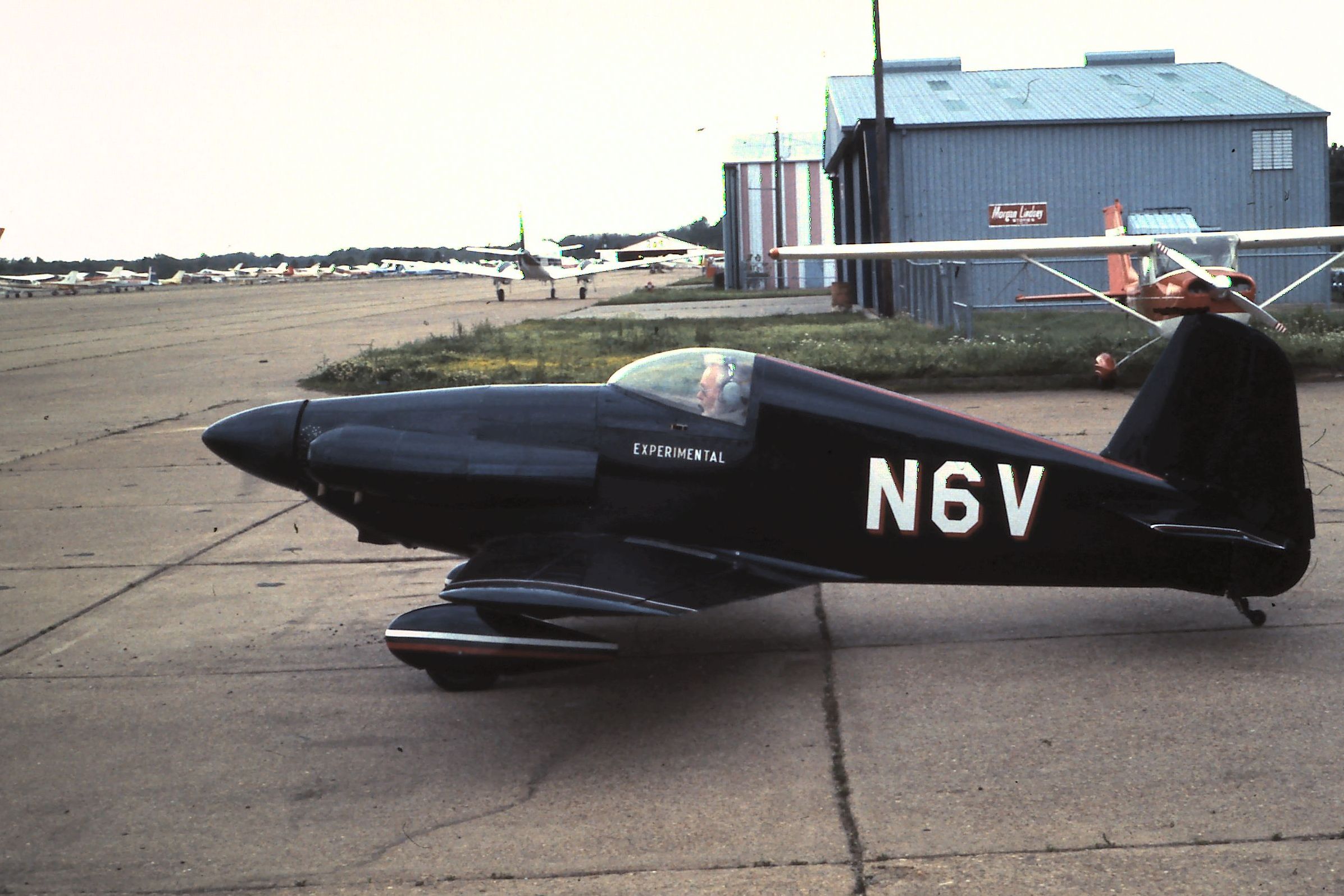 |
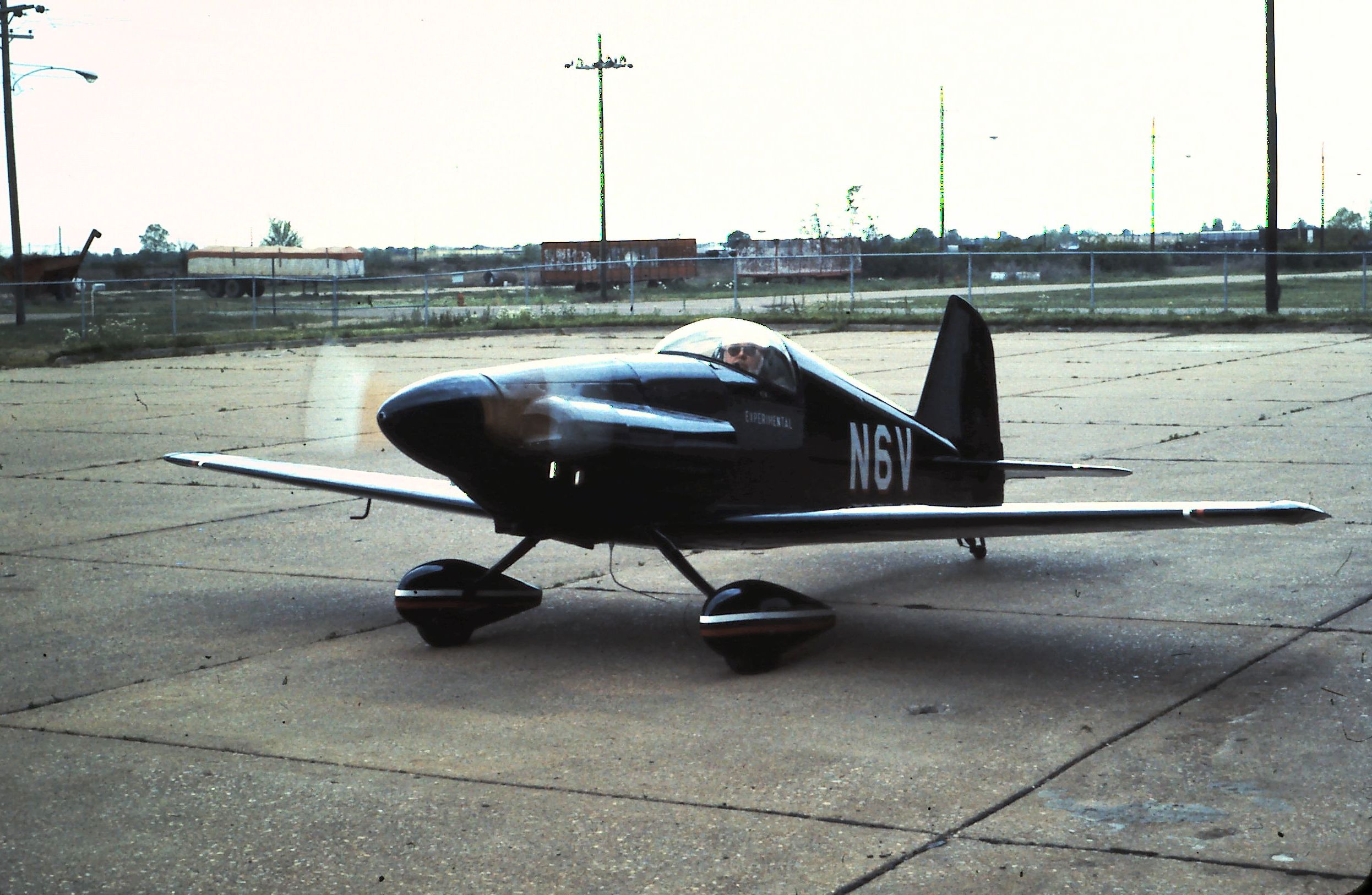 |
Up-Date of "Fossil"Since the events reported in the story by Jimmy Fordham in "Resurrection of a Fossil" (page 10), there have been further developments. Bob Speed sold the SNJ to a doctor from Richmond, Virginia, and left Jimmy and Dean without a toy. Fortunately (?) at about the same time they received word that Marion Cole was offering for sale the original Midget Mustang, a formula one racer. Specifically, this prototype of a very popular plane, which has been widely duplicated from this original, was built by David Long, using rented space in the Piper factory, in 1948. It is very small, weighing 525 1/2 pounds empty, holds 12 gallons of fuel (at 5 gph), and has an 85 hp continental engine. With a wingspan of 18' 5", a length of 16', and a height at the tail of 4'7", it is red-lined at 255 mph. It climbs, flies, rolls, loops, and runs like a dream. After about three minutes deliberation, the two reached a decision - and bought N6V, the Long LA-1. After a preliminary checkout for take-offs and landings in Marion Cole's two-hole Pitts, Jimmy and Dean are off and flying again. That makes for a resurrection of two fossils - and that's about as far as you can hope to go in one operation. We guess that flying is really here to stay. From Louisiana Flight Patterns, Vol. 6 No. 1, Spring 1978. |
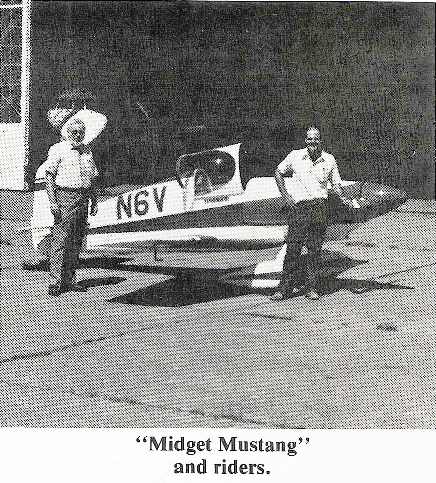 |
After completely stripping the plane and repainting it ...
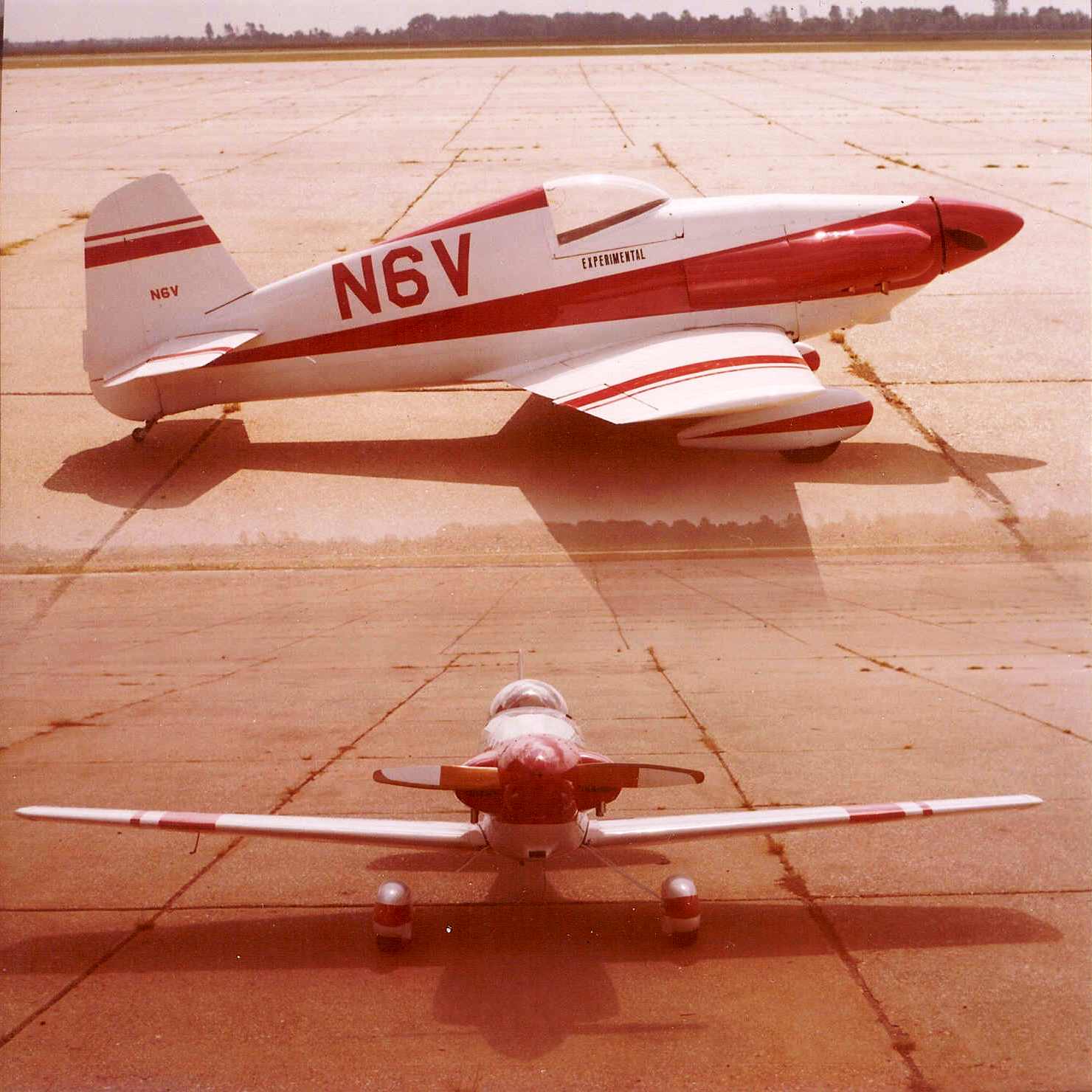 |
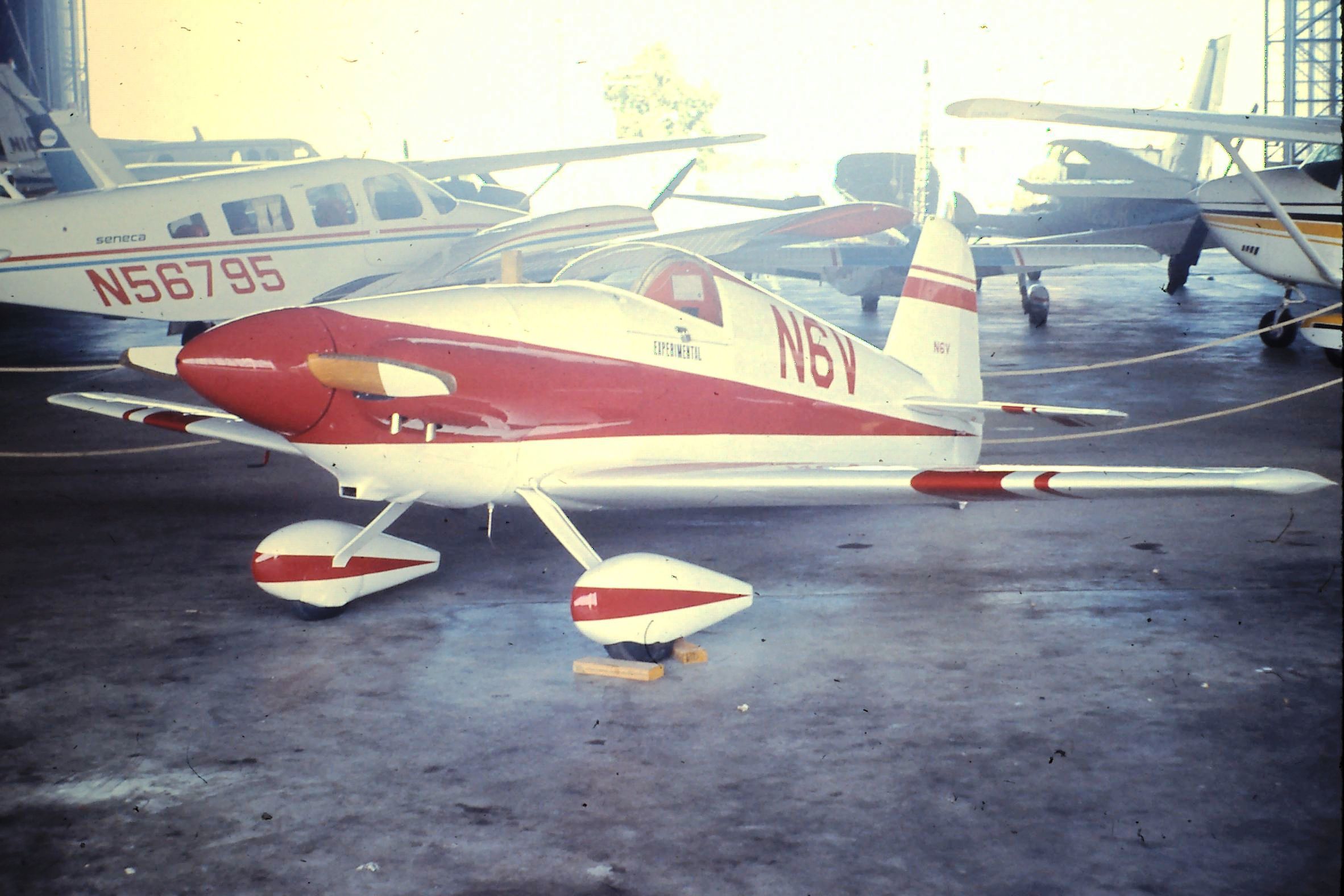 |
 Hartley in Midget Mustang |
In 1978 Hartley bought a Pitts Special.
Hartley "wearing" the Pitts Special |
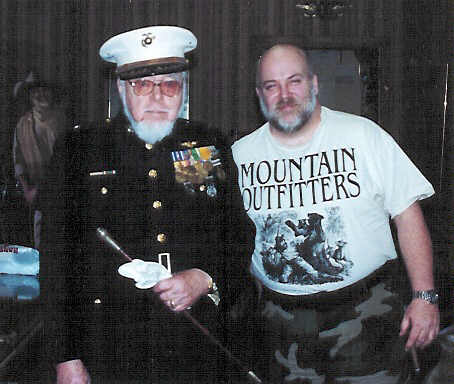 Col Hartley and friend Steve Norris at The Tobacconist in Monroe, LA, celebrating the 2002 Marine Corps Birthday |
Website created by Dean S. Hartley III.